![]()
![]()
![]()
Use LEFT and RIGHT arrow keys to navigate between flashcards;
Use UP and DOWN arrow keys to flip the card;
H to show hint;
A reads text to speech;
11 Cards in this Set
- Front
- Back
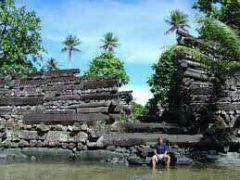
|
N. Nan Madol D. 700-1600 CE P/S. Saudeleur Dynasty A. The inhabitants of Nan Madol OL. Pohnpei, Micronesia P. The Saudeleur Dynasty M/T. Basalt Boulders and Prismatic Columns F. The ritual and ceremonial center for the ruling chief of the Saudeleur Dynasty. To organize and control potential rivals by inquiring them to live in the city rather than in their home districts. DT. Consist of a series of artificial islets linked by a network of canals. Complexes were built primarily from columnar basalt. More than ninety islets. Exhibition if the elite houses have revealed the presence of beads and other ornaments, which may have marked their owners social status. C. The islets were constructed by placing large rocks and fill atop submerged coral reefs to form raised platforms. They supported elaborate residential and ceremonial complexes. Have been home to a thousand people. Even though many of the residents were chiefs, the majority were commoners. Social hierarchy was reflected in the size of the residences built within the compounds. |
|
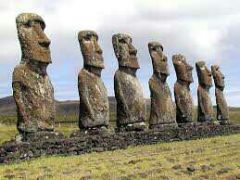
|
N. Moai on Platform (ahu) D. 1100-1600 CE P/S. 10th to 15th Century A. The inhabitants of Rapa Nui OL. Rapa Nui (Easter Island) P. Probably commissioned by a Hugh status individual M/T. Volcanic Tuff Figures on Basalt Base F. Religious ceremonies. Scholars believe it represent ancestrial chiefs. Easter islanders believed had the ability to accommodate spirits or gods. DT. Monumental sculptures as much as 40ft tall. Stand on silent sentinels. Planar facial figures. Large starring eyes. Strong jaws. Straight noses with carefully articulated nostrils. Elongated earlobes. Eye sockets were originally inlaid with red stone and coral and the sculpture was painted with red and white designs. Approximately weighed around four tons. Heavy eyebrow ridge. Emphasized clavicle and the nipples protrude. The arms are thin and lie tightly against the body. The hands are hardly indicated. Stern compromising expression. The figures back are covered with ceremonial designs C. The stand on marking burial or sacred sites used for religious ceremonies. A number of moai have pukakm the size and complexity of the maoi increased over time. Due to the introduction of Christianity in the 1860s, many remaining standing maoi were toppled. Keeper watch over over the island. Europeans took maois to show their king. The back is believed to be added in later by the birdman cult. The key birdman cult was an annual trial of strength and endurance, in. Which the chief and its followers competed against each other. The victorious chief then represented the creator god, Makemake , for the following year. The islands fragile ecosystem had been pushed beyond what was sustainable over time only sea birds remained. Most recently a theory concerning the introduction of rats would have left to famine and conflict |
|
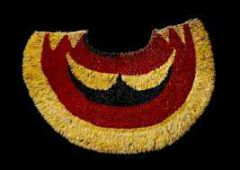
|
N. 'Ahu 'ula (feather cape) D. Late 18th Century P/S. 18th century A. Hawaiian OL. Hawaii P. Chief Man of the Hawaiian Hierarchy M/T. Feathers and Fiber F. Intended to visualize and reinforce the Hawaiian hierarchy; created for chiefly men of high rank DT. Every aspect reflected the status of the wearer. Full length cloak required up to 500,000 feathers. The sennit (plaited fiber or cord) is the structure where the feathers would have been attached was associated throughout Polynesia with deities. C. Some of the birds taken the feathers from yielded only six or seven suitable feathers. The cloak linked the it's owner to the gods. It also provided physical protection. The example originally belonged to King Kamehameha III, who gave it to Commodore Lawrence Kearny of the U.S. frigate Constellation in 1843 in gratitude for the Commodore's assistance during a temporary occupation of Hawaii protection. The example originally belonged to King Kamehameha III, who gave it to Commodore Lawrence Kearny of the U.S. frigate Constellation in 1843 in gratitude for the Commodore's assistance during a temporary occupation of Hawaii protection. The example originally belonged to King Kamehameha III, who gave it to Commodore Lawrence Kearny of the U.S. frigate Constellation in 1843 in gratitude for the Commodore's assistance during a temporary occupation of Hawaii |
|

|
N. Staff God D. Late 18th to early 19th Century CE P/S. 18th - 19th century A. Rarotonga People, exact is unknown OL. Rarotonga, Cook Islands, Central Polynesia P. Unknown M/T. Wood, Tapa, Fiber, and Feathers F. Exact function is unknown/ religious purposes DT. Deity figures. Carved out of wood both at the top and the bottom. The large central section is wrapped with decorative barkcloth. Carving at the top depicts a figure with smaller alternating female and male figures, projecting from the front of the body. C. In the early decades of the 19th century , Christians converted the islanders and destroyed their deities as part of the conversion process. The exact meanings of the primary and secondary figures are unknown due to the abrupt conversion to Christianity and the near total destruction of religious imagery in the early 19th century. Scholars theory; intended to represent familial descent and genealogy . alternatively, the procreative symbolism and multiple small figures found on the staff god may present a generative deity creating minor deities from his own body, |
|
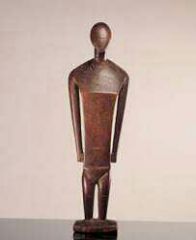
|
N. Female Deity D. 18th to 19th Century CE P/S. 18th to 19th Century A. Unknown OL. Nukuoro, Micronesia P. Unknown, most probably a Hugh ranking cheif/official. M/T. Wood F. Exact Meaning is Unknown DT. unique and minimalistic designs, very short legs, long strong arms, huge emphasis on the breasts. tiny and stylised small hands have carved fingers. The head is completely stylized. Pointy chin, small nose, on closer inspection she seems to be beaten. Contains a number of deep cuts. tattoos on the left side of the pubic area, a distinctive Nukuoro feature. C. It is said to be the evil goddess Kawe, likely to be one of the rare remaining artefacts of its dimensions known to exist, evil goddess known to have control over natural disasters and to take control of the island when the male god Iaigausema was absent, offered her goods to keep her evil doings away. Might have been placed outside originally due to the fact the wood is much more coarse. possibly the only large scale figure to have survived the transition to Christianity and abandonment of ancient beliefs. influential in the arts during the first half of the 20th century to European artist. |
|
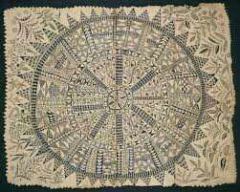
|
N. Hiapo (tapa) D. 1850-1900 CE P/S. 18th century A. Niue people OL. Polynesia P. Unknown M/T. Tapa or Bark Cloth, Freehand Painting F. Traditionally used for clothing, bedding, and wall hangings, textiles were often specially prepared and decorated for people of rank DT. Gender roles were clearly defines in the art works, generally to make barkcloth a woman would harvest the inner bark of the mulberry, the inner bark is then produced flat. Cultural exchange. Women may present tapas in exchange of work, food or to mark a special occasion. C. Records are known because of ethnogeography, journals, missionary records, archeology, linguistics, and oral traditions. Believe in the priority of the first born, artist were apart of the priestly class, tapa was ceremonially displayed on special occasions, in scared text tapa was used to wrap images of deities. Even today, they are integral in funerary ceremonies. In Polynesia were considered woman's health. |
|
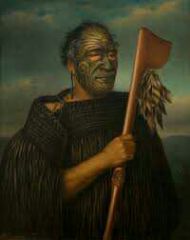
|
N. Tamati Waka Nene D. 1890 CE P/S. 19th century A. Gottfried Lindauer OL. Auckland, New Zealand P. Henry Partridge M/T. Oil on canvas F. To commemorate tamati waka nene; record likenesses and bring ancestral presence into the world of the living. DT. treasures passed down from the ancestors, wears a fine cloak covered in kiwi feathers, and an earring of greenstone or pounamu. holding a hand weapon known as a tewhatewha, which has feathers adorning its blade and a finely carved hand grip with an abalone or paua eye. Intricate facial tatoos. C. Portrait is an embodiment of tamati waka Nene, After a person has died their portrait may be hung on the walls of family homes and in the wharenui to be spoken to, wept over, and cherished by people with genealogical connections to them. Was chief of the Ngāti Hao people. converted to the Wesleyan faith and was baptised in 1839, choosing to be named Tamati Waka after Thomas Walke |
|
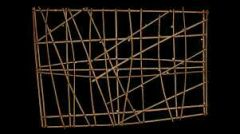
|
N. Navigation Chart D. 19th to early 20th Century CE P/S. 19-20th century A. Unknown OL. Marshall Islands, Micronesia P. Unknown M/T. Wood, Coconut Fiber, and shells F. Maps that showed land, but also the path from one island to the next, the water a sailor would cross during his voyage DT. Stick charts. Also called wapepe or mattang. Currents are represented by sticks held together by coconut fiber, the shell mark islands on route, the arrangement of sticks around a shell indicates a zone of distinctive waves shaped by the effect of an island deflecting the prevailing wind. C. Relied on celestial navigation (navigating by the sun, moon, and stars) as well as detailed understanding of the ocean currents and trade winds to travel from one island to another. Such refracted waves enable a navigator to sense the proximity of the land without being able to see it,and to discern the least difficult course for making landfall. Although it is primarily functional, its combination of clarity, simplicity, and abstraction has an aesthetic impact. |
|
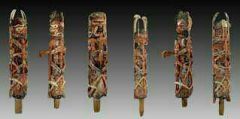
|
N. Malagan Display and Mask D. 20th Century CE P/S. 20th cen A. Unknown but collected by Hugh Hastings Romilly OL. New Ireland Province, Papua New Guinea P. Family of the dead however its is Unknown M/T. Wood, Pigment, Fiber, and Shell F. express many complex religious and philosophical ideas, DT. identity, kinship, gender, death, and the spirit world. rock cod features in an important myth of the founding of the first social group, or clan, both bid farewell to the dead and celebrate the vibrancy of the living, funeral rites could take place months after a person had died C. cycle of rituals of the people of the north coast of New Ireland, honoring and dismissing the dead, but they also act as affirmation of the identity of clan groups, and negotiate the transmission of rights to land, often include representations of fish and birds of identifiable species, alluding both to specific myths, when a piece is bought, the seller surrenders the right to use that particular Malanggan style, the form in which it is made, and even the accompanying rites, extremely expensive affairs, taking into account the costs of the accompanying feasting |
|
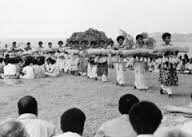
|
N. Presentation of Fijian mats and tapas cloths to Queen Elizabeth II D. 1953 CE P/S. 20th century A. Unknown OL. Fiji, Polynesia P. Unknown M/T. Multimedia Performance (costume, cosmetics, including scent; chant; movement, and pandanus fiber/hibiscus fiber mats), photographic documentation F. To document Queen Elizabeth's II historical visit to Fiji during a royal tour. DT. Shows an outdoor gathering including a procession of Fijian women wearing traditional clothing. Fijian women making their way through a group of seated Fijian men and women. Women dancers are wearing skirts with geometric patterns, Bold and intricate geometric patterns in red, white, and black are often painted onto the masi, each woman in the procession carries roles of women mats, simplicity is an indication of their importance C. newly crowned Queen Elizabeth II and her husband Prince Philip, Duke of Edinburgh arrived in Fiji for a royal tour. Which was then an English colony, is very likely that the women also presented the cloth to the Queen to celebrate the occasion of her visit. |
|
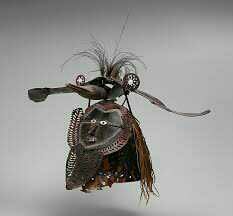
|
N. Buk (Masks) D. Mid- to late 19th Century CE P/S. 19th cen A. Torres Strait people OL. Torres strait P. Senior wearer M/T. Turtle Shell, Wood, Fiber, Feathers, and Shell F. Used during funerary ceremonies and increase rites DT. Native to the Torres strait island. Displays the composite human and animal imagery. Worn over the head as a helmet, this work depict a human face, it is surmounted by a frigate bird, perhaps representing his personal totemic species. C. First documented by Don Diego de Prado y Tovar in 1606. Rites are rituals designed to ensure bountiful harvest and an abundance of fish and game. Ceremonies often involved performances in which senior men, wearing the mask together with rusting costumes of grass, reenacted events from the lives of culture-heroes, drawn from local oral tradition. |

